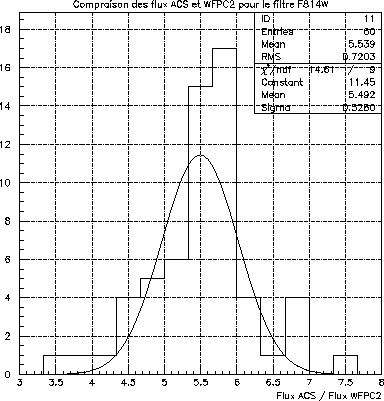The first approach, there too, was to use the objects of the field and to measure the relationship between fluxes on the reference and the image of follow-up. There still, the number of objects did not make it possible to obtain a sufficient precision. Figure 8.17 shows the histogram of the report/ratio of fluxes between the image of reference and an image of follow-up in filter F814W for the supernova 2001gn (with the major observations). The precision on the report/ratio of fluxes is only 10%, this for two reasons: the objects considered have weak fluxes and thus present a significant photometric error; the photometry of the galaxies is in practice very difficult if the basic levels of sky in the image are different.
 |
Space photometry being very stable, these photometric reports/ratios can be directly deduced in theory from zero points of the two instruments. However, at the time of this analysis, there did not exist yet of official calibration of camera ACS.
Items zeros that we used are those cordially provided by Marco Sirianni. They should give place to a rapid publication. These results are however preliminary and are of doubtful validity.
Provide with these zero points, exposure times of each image, we could estimate the values of the photometric reports/ratios of the various images. We in particular paid an attention significant to express the zero points in the same terms: while correcting for the variations of gain of the WFPC2, for the same aperture ...
For filter F814W, the value estimated thanks to zero points is in concord with the value found by using the photometric reports/ratios.
We thus thus could standardize the images of reference and bring them on the images of follow-up.
We will notice that in all this procedure, the images of follow-up of the supernovæ did not undergo any transformation. Only the images of reference undergo single a rééchantillonnage and a standardization.
This process was applied to all the images of follow-up so that we have from now on an image of the reference aligned for each one of it. We are able from now on to build the lightcurves.